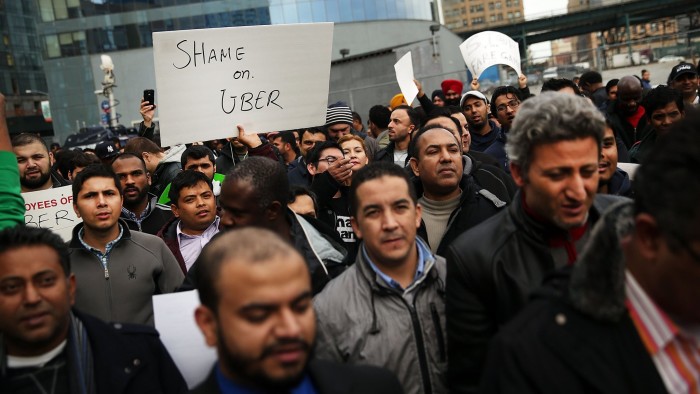Gap between gig economy’s winners and losers fuels populists


Roula Khalaf, Editor of the FT, selects her favourite stories in this weekly newsletter.
Technology can empower — but it can also enslave. Consider the daily work life of a typical taxi driver in New York, who might work for three or more companies at once: Uber, Lyft and perhaps even an unlicensed cab firm.
Such people are essentially entrepreneurs working for themselves, with all the freedom that entails. But they also bear the burden of innovations like “surge pricing”, in which computerised algorithms drive fares up or down in order to get more people into cars and make more money. They have to deal with any number of other complexities, such as working for multiple employers at any given time yet possibly receiving benefits like healthcare or pension from none of them.
Compare this with the life of a freelance management consultant. He or she may charge $10,000 a day per client, using cloud computing, smartphones, social networking platforms and video conferencing to work anywhere, anytime, which makes it easy to, say, earn a high six- or even seven-figure salary in dollars while also spending several months a year jetting between resorts or vacation homes. The price of a virtual assistant based in India is negligible. High-end freelance work spaces that are now available via membership schemes in a variety of cities means that the cost of office space is wildly reduced.
Clearly, the advent of the high-tech gig economy means very different things to these two kinds of workers. For the driver, it may feel like a kind of neo-serfdom. But for highly educated, mobile professionals such as the consultant, it is a way to earn more money in less time, in ever more flexible ways.
The digital gig economy, it turns out, is very divided. That matters to almost everyone, given that a spate of new research by various organisations, from McKinsey to the OECD, points to the fact that in the next 10 to 20 years, the number of people working as freelancers, independent contractors or for multiple employers will increase dramatically. In in the US, 35 per cent of the labour force is already working this way.
The dividing line in this new world of work is technology. The networking platforms and software of this new digital economy are resulting in cheaper prices for consumers, cost reductions for employers, and higher wages for the most skilled and educated workers who can do ever more highly paid work in less time.
But such technologies have also contributed to the concentration of wealth in fewer hands. In terms of wages, digitalisation “may have accelerated a divergence between the majority of workers and a smaller group at the top”, according to research by the McKinsey Global Institute (MGI).
“Think of, say, how a top surgeon using cutting-edge video conferencing technology might now be able to do more consultations in many different countries with a wide variety of clients,” says James Manyika, director of the MGI. “Compare that to a retail service worker whose life has been made chaotic by scheduling software that constantly changes his or her hours.”
This bifurcation is exacerbated by the fact that only a few sectors — information technology, communications, financial services and professional services — have adopted cutting-edge technologies in a significant way. In the US, workers in such areas of the economy enjoy twice the average national wage growth. Yet these sectors make up only about 19 per cent of the labour market. The largest sectors in terms of employment — such as healthcare and education — are less digitalised and, for the majority of workers, less lucrative.
There are large digital divides along national and international lines as well, which further exacerbates the “winner takes all” trend. For workers to exploit a more entrepreneurial, digitalised economy, whatever sector they work in, they need access to high-speed broadband, which is three times as likely in urban areas compared to rural ones.
There are even big gaps in digital opportunities in individual cities. In New York, for example, 80 per cent of residents in affluent Manhattan have access to broadband, while only 65 per cent of the poorer borough of the Bronx do. While the US has been the creator and exporter of many of the technologies are fuelling the 21st century economy, as a whole the country falls behind countries like the UK and Scandinavia in terms of the digital divide.
Bridging that divide is crucial for ensuring more sustainable, shared economic growth. An important point made in the IMF’s latest report on the world’s economic outlook is that countries and industries that are quickest to adopt new platform technologies are those that grow fastest and in the most sustainable manner.
There is plenty of low-hanging fruit that politicians could target on this front, from rural broadband investment, to putting social safety nets under workers in the gig economy.
In the US, there is a push for portable benefits that are not linked to a single employer and can be carried from one job to another. The EU is pushing to bring Uber drivers, couriers and other lower level service workers in the gig economy into national social security and healthcare systems.
Such campaigns are crucial not only for growth, but for political stability. It is no accident that in both rich and poor countries, people that are unable to take advantage of the benefits of the new gig economy are those that vote for populist political candidates. In a world in which technology has pushed ever more gains to the top, ensuring that the benefits of the digital gig economy are more widely shared will be crucial to ensuring any kind of growth at all.

Comments